Fiordland penguins (Eudyptes pachyrhynchus) are a fascinating type of penguin found only in the wilds of New Zealand’s Fiordland region. They are known for
In Maori, they are known as Tawaki, a reference to a god that walked the earth in human form. Whether or not you think these adorable penguins are gods or not, their elusive nature and remote habitat, making them a true treasure to spot and learn about.
In this article, we’ll take a look at some interesting facts about Fiordland penguins, covering everything from their physical characteristics and behavior to their habitat and conservation status.
1. Fiordland Penguins are endemic to New Zealand
On the mainland of New Zealand, they nest on the southwest coast of the South Island, from Bruce Bay to Coal Island. They are also found on offshore islands including Solander Island, Codfish Island, and Stewart Island.
When on land, they can be found in coastal areas, mostly occupying forests, sea caves, and rocky coastlines. However, they spend as much as 80% of their lives in the water1 (source: Penguins: Natural History and Conservation).
The below graphic maps out where penguins live across the southern hemisphere by species.
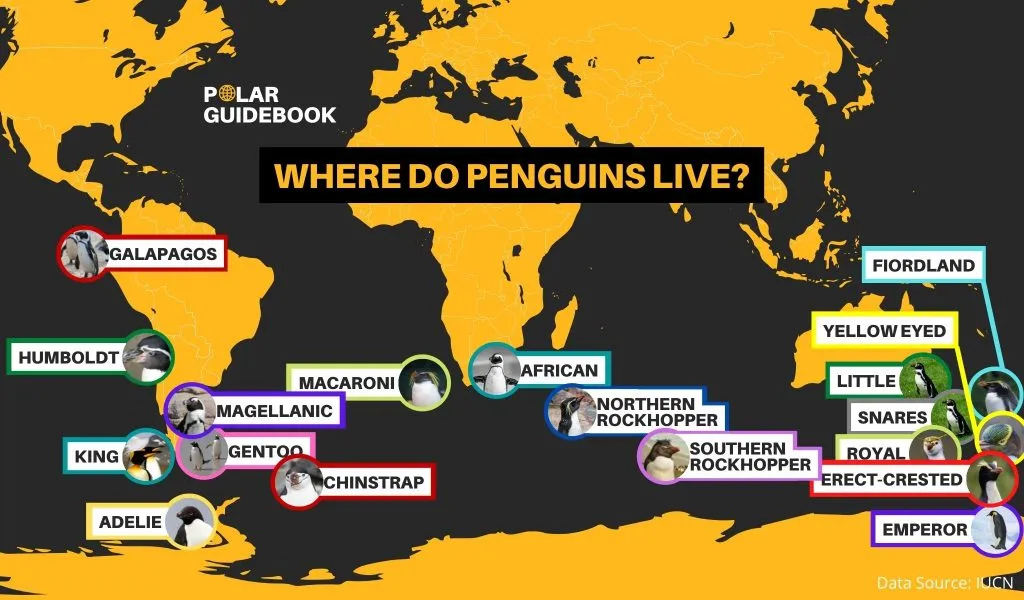
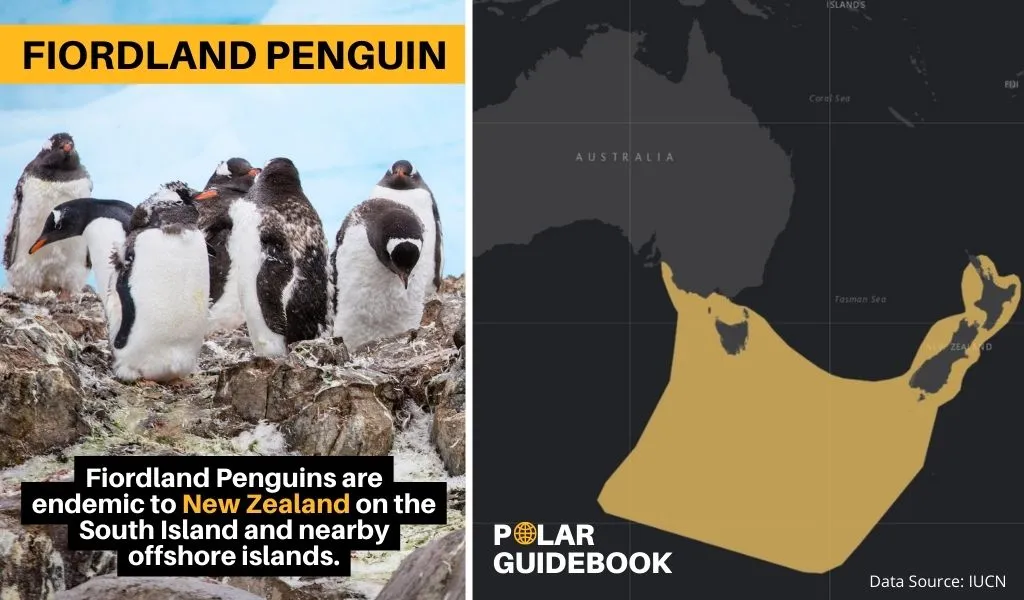
2. The lifespan of a Fiordland penguin is 10-20 years old
The lifespan of a Fiordland penguin in the wild is between 10-20 years old. This is just below average across the different species of penguins. Taking all species into consideration, it’s typical for penguins to live to around 20 years old.
In captivity, penguins live a little longer, typically around 30 years although there have been documented cases of penguins living to the ripe old age of 40 in captivity.
3. They are black and white to blend in with the ocean
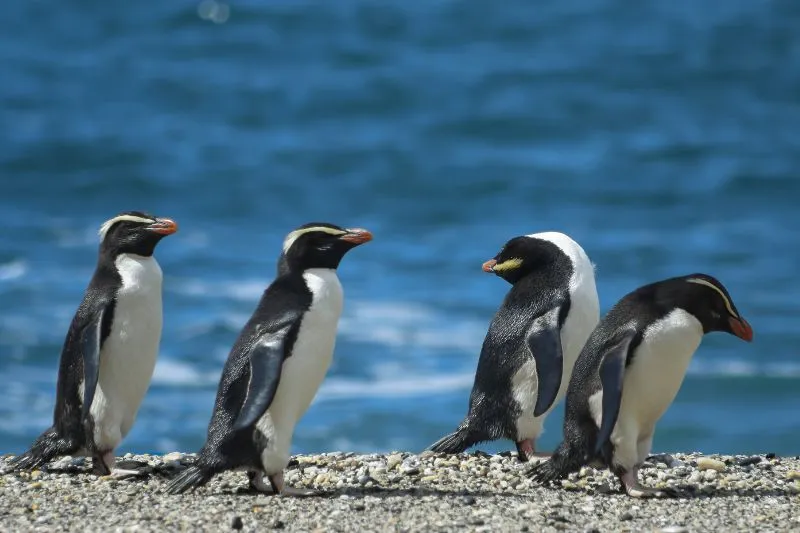
Penguins black and white tuxedo-style feathers are actually an important part of their camouflage.
They are white on their belly and black on their back. This is called countershading. It helps them blend in when they are underwater which is where most of their predators are found.
When you look at them from below, their white belly matches the light in the water above. And when you look at them from above, their black back matches the dark water below. So they are very hard to spot 2(source: H.M. Rowland, The Royal Society B Biological Sciences, Issue 364, 2008).
4. They are medium-sized penguins standing at around 71cm tall
Fiordland penguins are average-sized at 71cm (around 28″) tall. They can weigh anywhere between 2.5-3kg (6-7lbs) depending upon the season3 (source: Seaworld).
Here is a graphic showing how big penguins are by species.
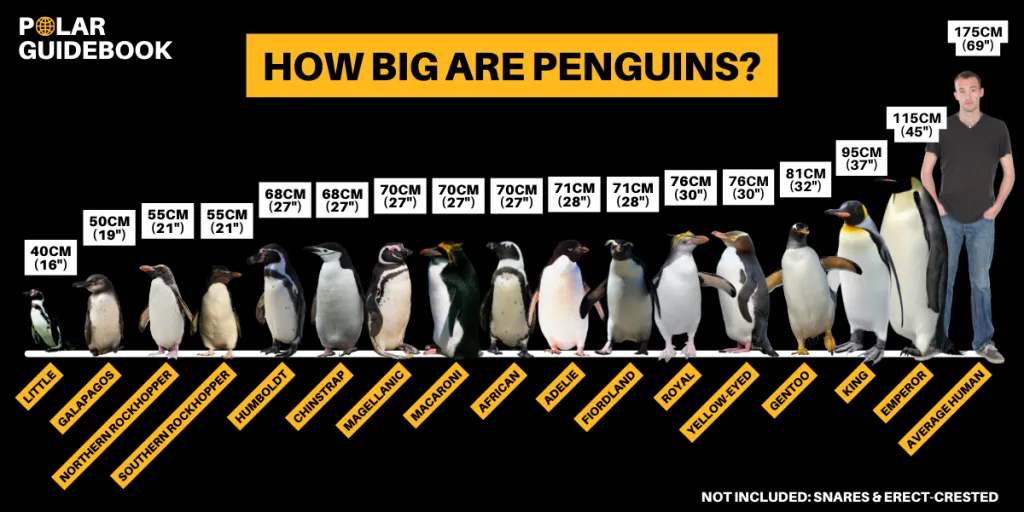
5. Their biggest predator is the stoat which was introduced by humans
Unlike most other penguin species, the biggest threats to Fiordland penguins are terrestrial predators.
On land, introduced predators such as stoats, dogs, cats, and wekas (a flightless bird endemic to New Zealand) are the biggest predators of Fiordland penguins4 (source: Britannica).
Not too much is known about their predators at sea, although it is likely that sharks, New Zealand fur seals, and sea lions prey upon them.
6. They are characterized by thick yellow feathers above each eye
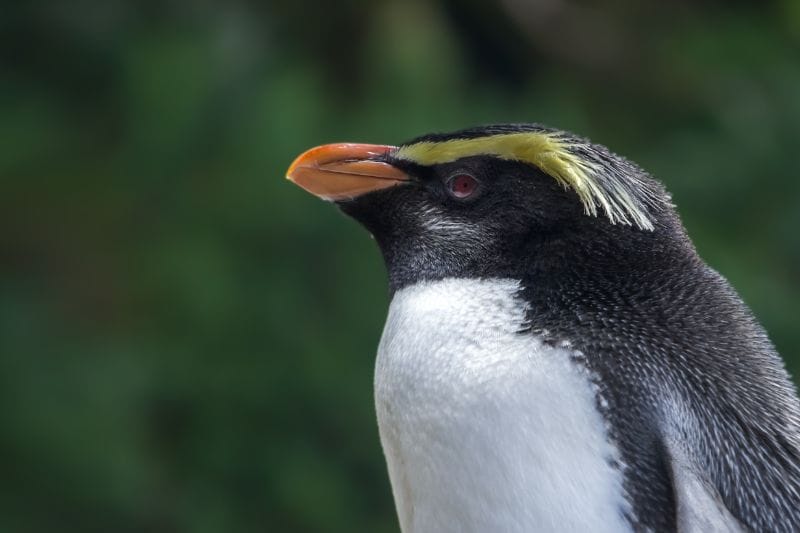
Fiordland penguins look very similar to Snares penguins which are another type of crested penguin also endemic to New Zealand. Both have similar thick yellow crest feathers above each eye.
Studies have found that these bright colors help them attract a mate by demonstrating that they are healthy enough to afford to compromise their camouflage5 (source: D. T. Ksepka, American Scientist).
The main way to tell the difference between Snares and Fiordland penguins is that Fiordlands have pink skin around their bill whereas Snares do not. You can also identify them by the white stripes on their cheeks, they are the only crested penguin to have this6 (source: Seaworld).
7. They can drink salt water through a dedicated salt gland
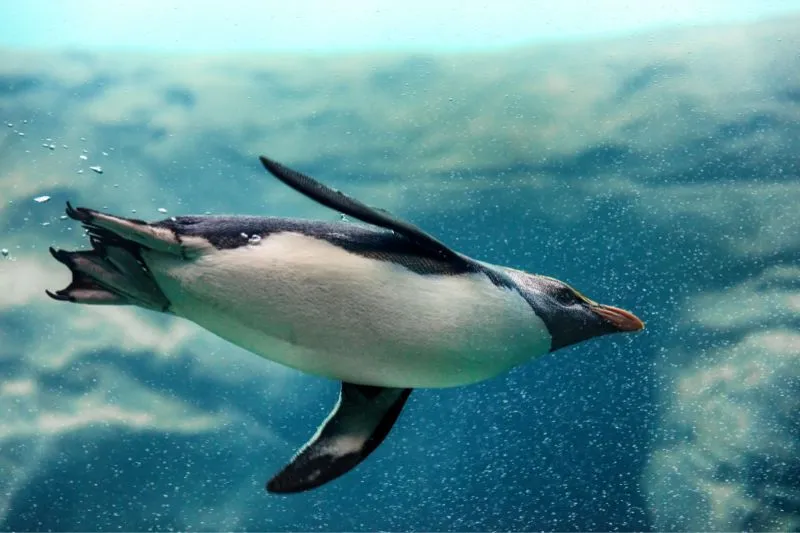
Fiordland penguins spend most of their lives at sea or around coastal areas of New Zealand where the only water available for consumption is saltwater.
Because their kidney is not very efficient at processing salt, they have a dedicated salt gland (known as a super orbital gland) at the top of their skull, near their eye, which removes salt from their blood.
The salt is excreted in water droplets through their nostrils by sneezing or shaking their head7 (source: Britannica).
This means that penguins don’t need to worry about ingesting salt water as they catch and eat their prey out at sea.
8. They lay two eggs but usually only the second will survive to adulthood
When breeding, Fiordland penguins will lay two eggs. The first egg is usually much smaller than the second and is often discarded by the mother who may refuse to incubate it or push it out of the nest.
Instead, she will put all of her focus on incubating the second, larger egg. This is common among all crested penguin species.
The most likely reason for this behavior is that the first egg is ovulated whilst the mother is still out at sea so she cannot yet fully commit herself to the egg whilst also putting effort into swimming. This is why the first egg is always smaller and doomed from the outset8 (source: National Geographic).
9. Both males and females play a role in raising offspring
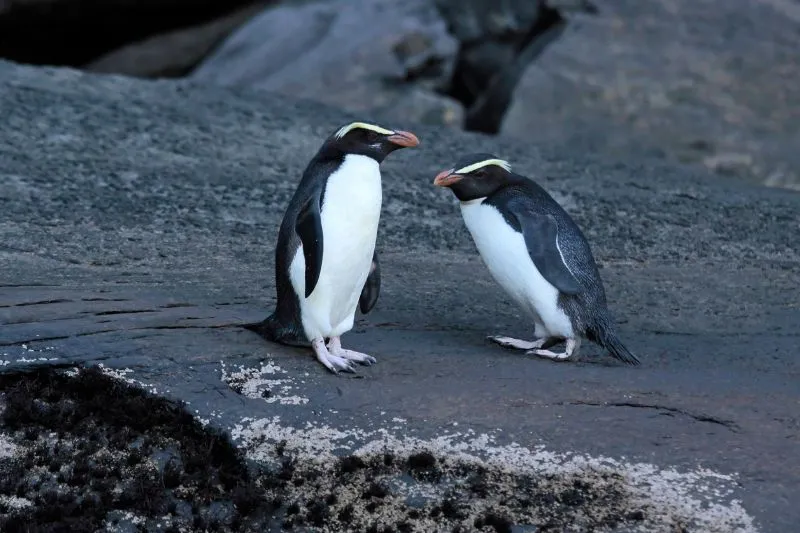
Right from the outset, parenting duties are shared, starting with incubation. Males and females take turns incubating the eggs whilst the other parent forages for food at sea.
Once the chicks are born, they enter the guarding stage where the male will stay at the nest to protect the newly born chicks. The females will forage for food at sea and return to feed the chicks each night.
Once the chicks are three weeks old, they can be left in large groups with other chicks (called a creche) while both parents forage for food, although the female is still the main contributor to the chick’s diet9 (source: Penguins: Natural History and Conservation).
10. They are very shy penguins
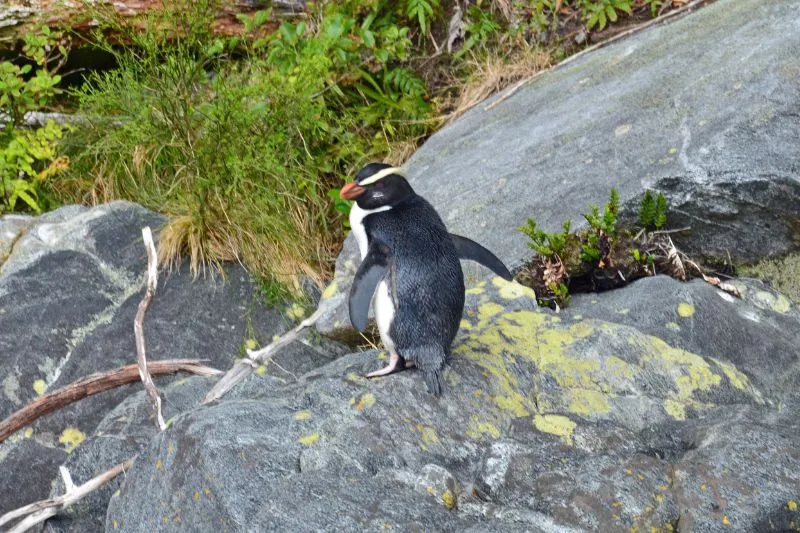
Fiordland penguins are very shy and timid so they can easily be disturbed by humans. These disturbances have been associated with population declines at colonies in South Westland which are more accessible, although a full study has not been done10 (source: IUCN).
Unlike other penguin colonies which are usually densely packed, they like to build their nests several meters away from one another so a colony can be spread out across long stretches of coastline.
They tend to build their nests at the bases of trees, underneath the roots, or in crevices of rocks. They will use grass, twigs, and stones to complete the nests. Although they are social with each other, they also spend some time alone in the nest or shady areas out of the heat.
11. Barnacles can grow on their tails after long periods at sea
Fiordland penguins can spend up to 75% of their lives at sea so they are known to grow barnacles on their tails11 (source: Seaworld).
These are small crustaceans that are usually seen attached to the underside of ships or other objects that spend a lot of time in the ocean12 (source: NOAA).
12. There are around 12,500-50,000 Fiordland penguins left in the wild
Estimates of the Fiordland penguin population vary but generally place it between 12,500-50,000. This makes the Fiordland penguin one of the smallest penguin species by population compared to the total 30-31 million worldwide penguin population.
They are considered vulnerable by the IUC because they only inhabit one island and are susceptible to natural disasters and human activities. Vulnerable is one level better than endangered on the IUCN’s scale.
One of the biggest threats to Fiordland penguins is introduced predators such as stoats and dogs which prey on them. As with all penguin species, local fisheries and bycatch are also threats to their survival13 (source: IUCN).
The below graphic is from out article on are penguins endangered and shows the rating for each species according to the IUCN.
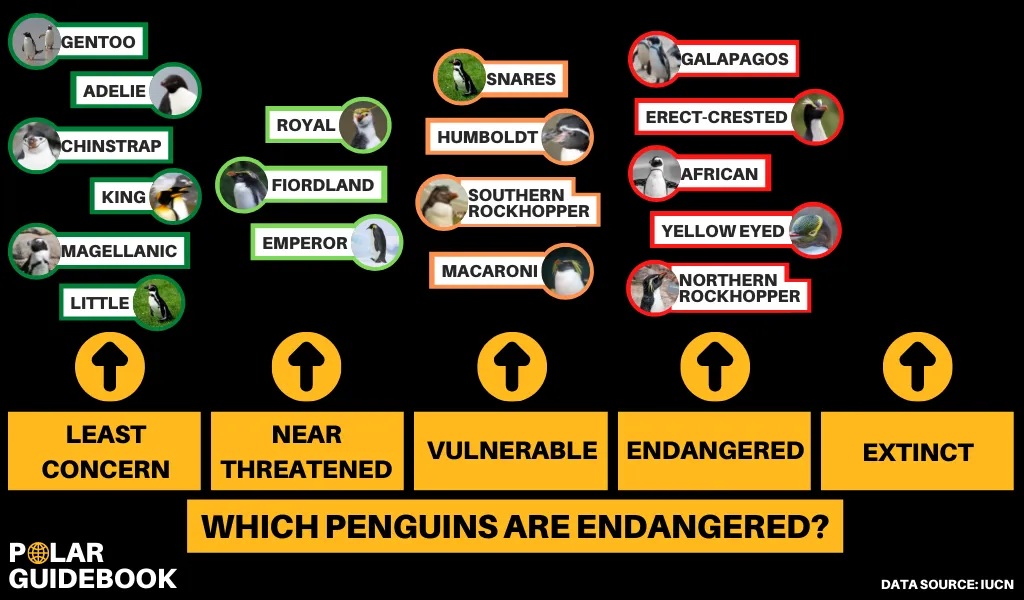


![You are currently viewing 12 Fascinating Facts About Fiordland Penguins [#4 is Hard to Believe]](https://polarguidebook.com/wp-content/uploads/2023/01/Fiordland-Penguin-2.jpg)
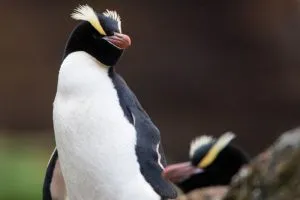
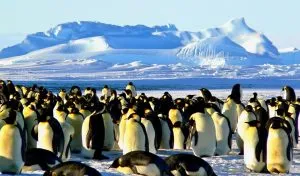
![Read more about the article 12 Ice-Cool Facts About Adélie Penguins [#9 Will Surprise You]](https://polarguidebook.com/wp-content/uploads/2023/01/Adelie-Penguins-Jumping-Over-Ice-300x200.jpg)